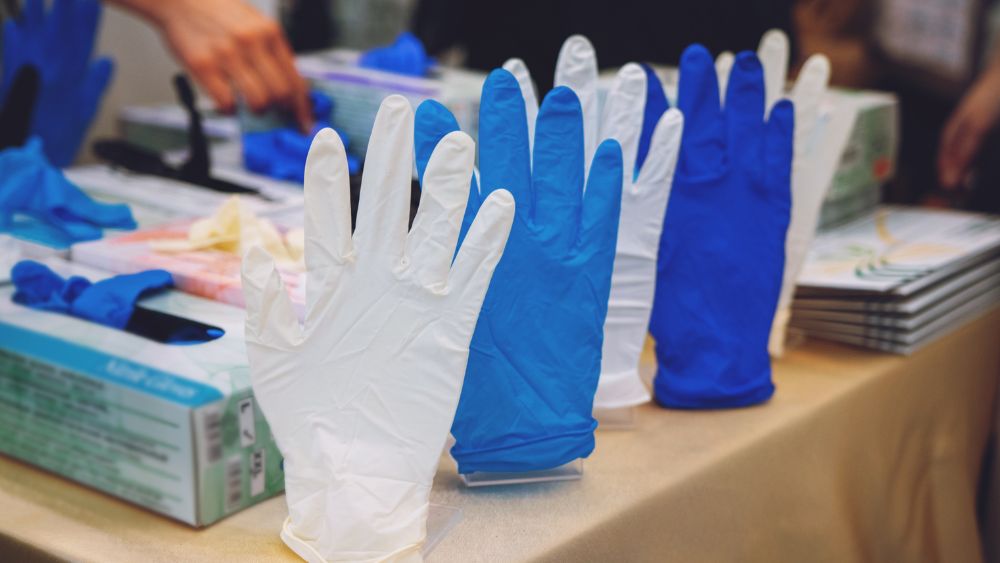
Latex and nitrile gloves
What is the difference between latex and nitrile gloves and which material is best suited? And what types of gloves are actually available?
Disposable gloves play an important role in maintaining hygiene standards.
Which material is best suited for which areas and activities depends, for example, on the application, specified standards and possible allergies.
You should know the following before buying or using disposable gloves:
What is the difference between latex and nitrile?
Latex is a natural product and is also known as natural rubber. It is a rubbery substance in the milky sap of various rubber plants. Nitrile, on the other hand, is an artificial substance. This synthetic rubber is a chemical compound of carbon and triple-bonded nitrogen. Nitrile is similar to latex in many properties and is usually in no way inferior to it. The biggest difference lies in the areas of resistance and skin sensitivity, as explained below:
Properties of nitrile gloves
Nitrile gloves are particularly robust, abrasion and puncture resistant and therefore offer a particularly high protection factor. The material is much denser than latex, which makes it possible to manufacture thinner gloves. This results in pleasant wearing comfort and good tactile sensitivity.
Nitrile is particularly resistant to viruses, chemicals, solvents, fats and oils. When handling food, it must always be ensured that no residues remain and that the gloves are approved accordingly.
Today, 95% of nitrile gloves are already used in hospitals and doctors' surgeries. They cannot cause allergies as they are latex-free and there is no hypersensitivity to nitrile. They are therefore perfectly tolerated by allergy sufferers.
As this material is particularly easy to dye, there is often a wider choice of colors.
Properties of latex gloves
Latex gloves are very hard-wearing, stretchy and flexible. The high elasticity ensures that they are easy to put on and fit perfectly, and despite the dense material thickness, they are very comfortable to wear. Due to their water resistance, they offer a good wet grip.
Latex is resistant to non-aggressive chemicals such as weak acids or alkalis. However, as the material is permeable to grease, it is not suitable for handling food. In particular, contact with oils and fats should be avoided.
Allergies may occur in some people due to the latex proteins it contains.
Without coloring, the material looks slightly yellowish. However, there are now also variants in white or black.
What types of gloves are there?
There are disposable medical gloves for protection against biological substances, disposable PPE gloves for protection against exposure to chemicals and biological substances and textile undergloves to reduce perspiration.
There are also gloves with a longer shaft so that they can be pulled over clothing, such as veterinary gloves. Washable twisted gloves are suitable for coffin bearers and thanatologists like to use extra thick gloves.
All gloves in the Lavabis range are waterproof and approved for medical use. Glove boxes are useful for removing gloves easily and hygienically.
Recommended products for this article:
►Nitrile gloves black: https://bit.ly/3J3JPNp
►Nitrile gloves white: https://bit.ly/3oxBcBk
►Latex gloves natural: https://bit.ly/3osZX1m
►Latex gloves black: https://bit.ly/3BfixBN
►Twisted gloves white: https://bit.ly/3OAutRt
►Wall mount glove box: https://bit.ly/3OApEYg
Watch this blog post as a video:
Click here for our socials:
►Website: https://www.lavabis.de/
►YouTube: https://bit.ly/3bMZLqE
►Facebook: https://www.facebook.com/lavabis
►Instagram: https://www.instagram.com/lavabis_com/
►Newsletter: https://bit.ly/3AremCh


